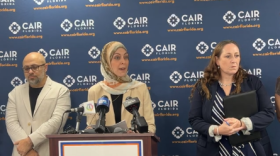For those hitting the beach on this first unofficial summer weekend after Memorial Day, there’s a decent chance that when you get done ridding your shorts of all that sand, similar grains will waft down from the sky.
It’s not sand, exactly, but it was in the Sahara Desert a few days earlier. How the microns-wide dust particles get from there to here is an amazing voyage.
To follow the remarkable journey of a Saharan dust cloud has definite Hollywood potential. Imagine the dusty grains of quartz and mica going into a creative potion made by Harry Potter, who gives it to “imaginarian” Walter Mitty.
Following the dusty mixture, Mitty ascends several miles up from the desert dunes to share air space with turbo-props and regional jets, then catches strong trade winds and zips west at highway speed on a four-day trip.
Along the way, Mitty uses the mix to tame hurricanes, help grow fish food in the ocean, beautify sunsets, trigger asthma attacks, turn blue skies white, and make driving in Florida more dangerous than it already is.
At the end of the movie, Mitty realizes he’s standing in for nature herself.
In reality, all of that usually happens. Meteorologists call it the Saharan Air Layer.
Hurricane killer; sunset booster
Maybe because they are often described as a cloud of iron particles coming from Africa, and iron helps suppress hurricanes, it’s not clear that Saharan dust clouds are a regular weather process that happens between Africa and southern parts of America every year.

The mass of very dry, dusty air that forms over the Sahara Desert at times from the late spring to early fall travels thousands of miles. NOAA, in an online report, said that long journey is a reason the agency uses high-flying satellites to track it. NOAA also explains the phenomenon in detail online.
“The Saharan Air Layer has unique properties of warmth, dry air, and strong winds that can act to suppress hurricane formation and intensification,” NOAA wrote online. “Thanks to recent advancements in satellite technology, we can better monitor and understand the SAL, from its formation over Africa, to its interactions with tropical cyclones, to its impacts on weather along the U.S. Gulf coast and Florida.”
Every year, it travels across the Atlantic and can reach Southwest Florida. This phenomenon is closely watched by meteorologists in cities such as Cape Coral and Fort Myers because when the Saharan Air Layer is present, hurricane activity in the Gulf of Mexico and surrounding areas is often reduced, providing a temporary break during the six months of hurricane season.
Dry air inherently lacks moisture, which makes it difficult for hurricanes to get going. If a tropical system manages to begin gathering strength when a Saharan Air Layer is above, the increased wind shear can pull the developing system apart.
From the Atlantic Ocean off Africa to Gulf waters near Southwest Florida, the dust clouds drop particles of iron, phosphorus, and nitrogen. These nutrients spur the growth of phytoplankton, which are microscopic plants at the base of the ocean’s food chain. The dust-driven phytoplankton bonanzas help support fish populations, which in turn benefits both commercial and recreational fishing.
The minerals from the dust also play a role in supporting seagrass and coral reef health, both of which are vital for marine life.
Marine scientists at Florida Gulf Coast University have studied aspects of Saharan dust’s environmental impacts, including potential links to red tide and algae blooms.
Saharan dust in the atmosphere also changes the way sunlight is scattered, and since every color is in sunlight, that leads to more vivid and colorful sunsets.
The dust can turn the sky brilliant shades of orange, red, and pink. These striking skies are especially noticeable in the evenings, and photographers have a field day.
When the dust concentration is at its highest, the effect is most pronounced, making summer sunsets along the Gulf Coast particularly sweet for everyone.
However, for some, Saharan dust in the atmosphere poses a health risk.
Hospitals and clinics in Florida often see more cases of asthma attacks and respiratory irritation when the dust is thick. The fine particles can make breathing difficult, especially for children, seniors, and people with existing lung conditions. Those folks are encouraged to stay indoors when dust levels are high and use air conditioning and air filters.
Another danger of heavy Saharan dust is that it can make Southwest Florida’s normally clear, blue skies appear hazy or even white. That reduces visibility, which makes driving more challenging.
The Florida Department of Transportation did a study that found drivers distracted by cell phones, loud radios, and eating already cause crashes that kill nearly 300 people in the state every year.
Add to that hazy days and intense colors of dust-enhanced sunsets, and Saharan dust could become another distraction.
Interconnected planet
NOAA said the Saharan dust cloud arriving in Florida this weekend will bring with it that very mix of natural spectacle and practical challenges.
Cars, mailboxes, and lawn furniture may end up with a slight coating of iron-colored dust, which many would consider a minor cost of admission to a show of super-colored sunsets.
But if you somehow manage to miss this one, there’ll be more. This year, and next.
“It’s a vivid reminder of how interconnected our planet’s weather systems truly are,” NOAA wrote on the social media platform X. “Linking the world’s largest desert to the skies above the Sunshine State.”
Environmental reporting for WGCU is funded in part by Volo Foundation, a nonprofit with a mission to accelerate change and global impact by supporting science-based climate solutions, enhancing education, and improving health.
Sign up for WGCU's monthly environmental newsletter, the Green Flash, today.WGCU is your trusted source for news and information in Southwest Florida.
We are a nonprofit public service, and your support is more critical than ever. Keep public media strong and donate now. Thank you. WGCU is your trusted source for news and information in Southwest Florida. We are a nonprofit public service, and your support is more critical than ever. Keep public media strong and donate now. Thank you.








